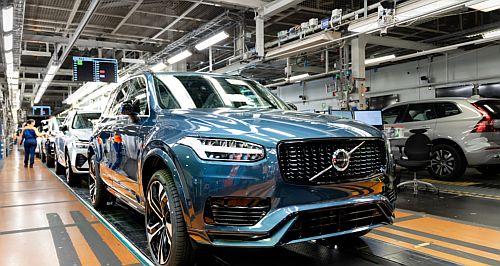News - VolvoVolvo ends diesel engine productionSwedish car maker farewells compression ignition engine, last vehicle headed to museum29 Mar 2024 By MATT BROGAN VOLVO has officially ended production of its compression ignition engine with the last diesel-powered vehicle – a blue XC90 – rolling off the assembly line in Torslanda, Sweden this week.
The Scandinavian car maker says the event marks a “huge milestone” in the company’s 97-year history and is a big step towards its ambitions on becoming a fully electric vehicle manufacturer.
Acknowledging a time when diesel engines were synonymous with reliability and efficiency, Volvo says its diesel-powered cars played a significant role in its evolution into a premium brand but admits the electric evolution has arrived much quicker than originally forecast, propelling it and many others to respond to changing regulatory demands.
Volvo said that in 2023, sales of its battery electric models increased to 70 per cent in Europe and 34 per cent globally, underscoring the all-electric direction in which the brand is now headed.
Volvo said it will continue to offer mild-hybrid and plug-in hybrid petrol models as part of the model mix for the foreseeable future.
The last oil-burner built – one of an estimated nine million to wear the Volvo badge since 1991 – is destined to live out its years in the World of Volvo Museum in Gothenberg.
Volvo introduced diesel power to its passenger range with the 244 GL D6 in 1979. The vehicle utilised a Volkswagen-sourced naturally aspirated unit that saw extensive use in taxi and rental fleets.
The Swedish manufacturer did not produce its own diesel mill until 2001 when the D5 five-cylinder engine was produced in-house at Skovde, Sweden. Arriving initially in the V70, the unit went on to see service in a wide range of Volvo models, even used in the S60 Challenge race car and in marinised form by Volvo Penta.
In 2008, smaller capacity (1.6-litre) diesel engines arrived as part of Volvo’s Drive-E offensive, the ultra-frugal units capable of delivering extraordinary range and low CO2 emissions. The range was upstaged four years later by the D6 plug-in hybrid engine, the world’s first plug-in hybrid diesel-electric powertrain for a passenger car.
The following year (2013) saw a second ‘first’ for Volvo when it launched a completely in-house designed VEA (or Volvo Engine Architecture) line of engines. It is this design that powered diesel Volvo models through to the end, the company announcing its decision to discontinue compression ignition engines in 2017.
Seven years later, that announcement is realised. Volvo has now sold its stake in Aurobay – the combustion engine joint venture it held with parent Geely Holding – and finalised production of the diesel range.
According to the European Manufacturers’ Association (ACEA), diesel-powered passenger vehicle market share in Europe dropped from 16.4 per cent in 2022 to 13.6 per cent in 2023.
Battery electric vehicles (BEVs) were more popular last year (14.6 per cent), while plug-in hybrid vehicles accounted for more than half that number (7.7 per cent). Petrol-electric hybrid (HEV) vehicles now represent 25.8 per cent of the European new car market while petrol-powered cars hold a 35.3 per cent market share.
Other propulsion types balance out the remaining three per cent.
 Read more26th of March 2024  Polestar 3 slashes emissions footprintCradle-to-gate carbon footprint of Polestar’s first SUV lower than smaller Polestar 2’s26th of March 2024  Volvo S60 and XC60 Black Edition announcedBlack Edition variants join Volvo S60 sedan, XC60 SUV ranges in limited numbers from April15th of March 2024  First heavy-duty Volvo BEV truck hits the roadFollowmont Transport puts first heavy-duty Volvo electric truck to work Down Under15th of March 2024  Volvo Trucks incoming FH16 most powerful yet3800Nm Volvo Trucks FH16 to offer serious power, bio-fuel alternative in Aussie market |
Click to shareVolvo articlesResearch Volvo Motor industry news |
















Facebook Twitter Instagram